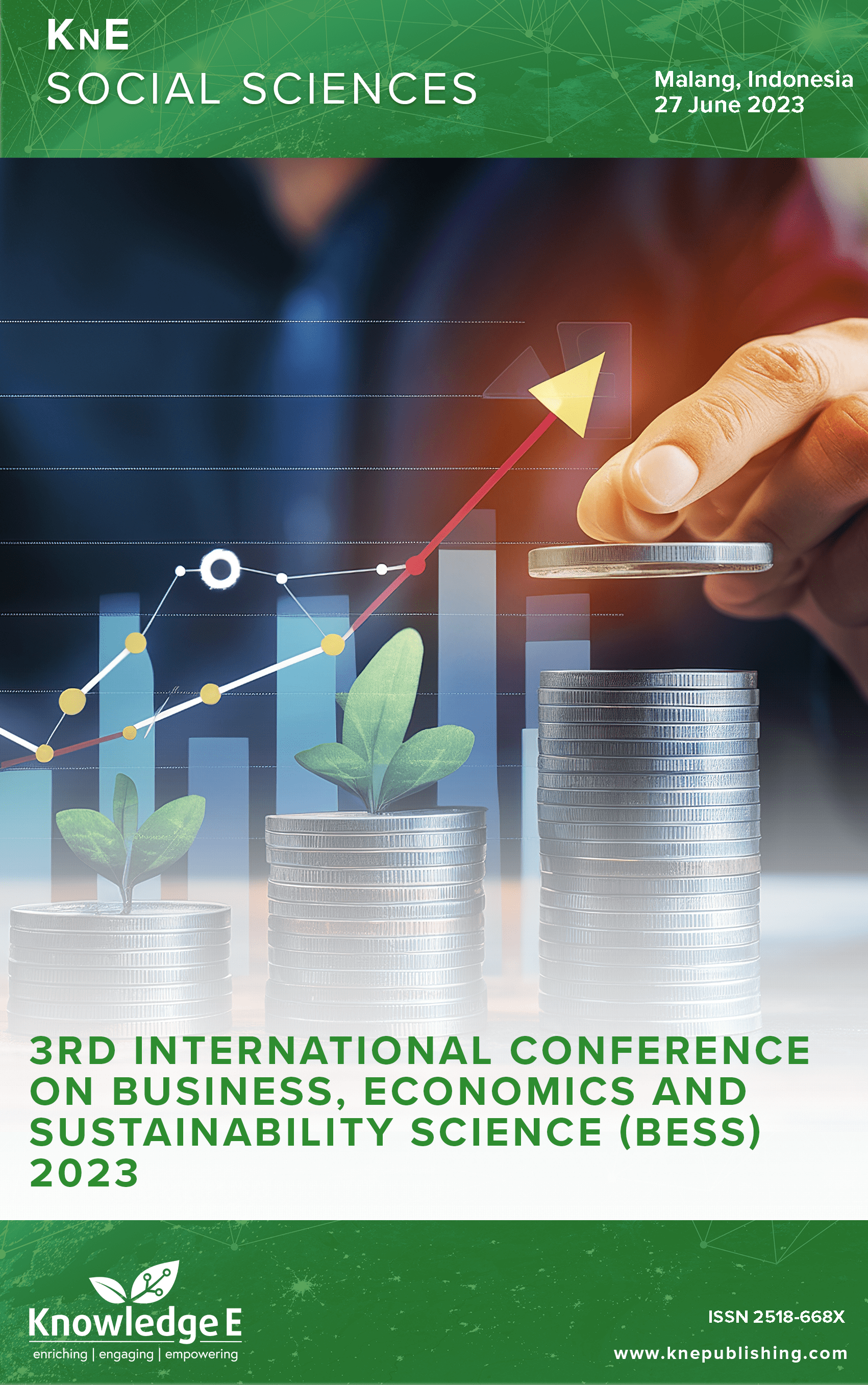Strategy to Optimize the Potential of Bamboo Products in Petungsewu and Pandanrejo Villages, Wagir District, Malang Regency
DOI:
https://doi.org/10.18502/kss.v9i21.16736Abstract
The production of processed bamboo products has a great potential for establishing welfare among the people of Petungsewu and Pandanrejo villages, Wagir sub-district, Malang district. However, the bamboo products in these villages are still manufactured traditionally and at a smaller scale. The condition of MSMEs in these villages also lacks priority over raw materials, marketing, technical production, and expertise. Therefore, the purpose of this study is to analyze the optimization of processed bamboo products so that they develop rapidly and support the sustainable development goals, optimize creativity, identify problems that cause bamboo products to be constrained and preserve the environment to create go-green areas and improve the economy of the local people in Petungsewu and Pandanrejo villages, Wagir subdistrict, Malang district. This study uses a quantitative approach with SWOT analysis which aims to determine strategies that can be used to develop and maintain the business. Data used are primary data obtained from observation activities and through questionnaires. The primary data obtained were analyzed statistically using SEM and operated through the SMART PLS program. The SWOT analysis is also equipped with analytical methods (Internal Factors Analysis Summary) and EFAS (External Factors Analysis Summary) to determine the SWOT Quadrant Positioning.
Keywords: optimization, local economic development, processed bamboo products
References
Adi RK. ANALISIS PEMETAAN STATUS PENGEMBANGAN EKONOMI LOKAL (PEL) DI KABUPATEN SUKOHARJO. 2012.
Amstrong G, Philip K. Dasar-Dasar Pemasaran. Jilid I, Alih Bahasa Alexander Sindoro dan Benyamin Molan. Jakarta: Penerbit Prenhalindo; 2012.
Bambang, Suprapto. Sinergitas Kebijakan Local Development dan Pembangunan Pedesaan Sebagai Upaya Peningkatan Daya Saing Desa. Journal Proceeding FEB Universitas Jendral Sudirman. 2014:4(1).
Biggart NW. Readings in Economic Sociology. Blackwell Publishers Ltd.; 2002. https://doi.org/10.1002/9780470755679 DOI: https://doi.org/10.1002/9780470755679
BKKBN. Rencana Strategis Badan Kependudukan Dan Keluarga Berencana Nasional Tahun 2015-2019. Badan Kependudukan Dan Keluarga Berencana Nasional; 2015.
Brown RD, Petrello GJ. Introduction to business, an integration approach. Beverly Hills: Glen Coe Press; 1976.
Halim A. PENGARUH PERTUMBUHAN USAHA MIKRO, KECIL DAN MENENGAH TERHADAP PERTUMBUHAN EKONOMI KABUPATEN MAMUJU. 1(2). 2020. DOI: https://doi.org/10.46821/bharanomicss.v1i1.14
Midgley J. Social development. The development perspective in social welfare. London: Sage Publication; 1995.
Naiyati S, Simanjuntak RA. Sinergisme Komponen Pengembangan Ekonomi Lokal Untuk Peningkatan Kesejahteraan Sosial di Kawasan Perdesaan Telang dan Batu Betumpang. Kajian Ekonomi dan Keuangan. 2016:19(3):218–245. https://doi.org/10.31685/kek.v19i3.143 DOI: https://doi.org/10.31685/kek.v19i3.143
Nikawanti G. Ecoliteracy: Membangun ketahanan pangan dari kekayaan maritim Indonesia. Jurnal Kemaritiman. Indonesian Journal of Maritime. 2021;2(2):149–65. DOI: https://doi.org/10.17509/ijom.v2i2.37603
Nurwanda A, Badriah E. Analisis Program Inovasi Desa Dalam Mendorong Pengembangan Ekonomi Lokal Oleh Tim Pelaksana Inovasi Desa (Pid) Di Desa Bangunharja Kabupaten Ciamis. Dinamika. Jurnal Ilmiah Ilmu Administrasi Negara. 2020;7(1):68–75.
Rahmansyah N, Aryadi M, Fauzi H. STRATEGI PEMBERDAYAAN MASYARAKAT LOKAL BERBASIS BAMBU DI KECAMATAN LOKSADO. Jurnal Hutan Tropis. 2020;8(1):91–8. DOI: https://doi.org/10.20527/jht.v8i1.8165
Rahmawati A, Febriarto P, Nugroho HS. Peningkatan Kapasitas SDM Melalui Manajemen Jaringan Usaha Produk Kerajinan Bambu UKM Pring Gedhe Dusun Brajan Kecamatan Minggir Kabupaten Sleman. Society. Jurnal Pengabdian Masyarakat. 2022;1(2):95100. DOI: https://doi.org/10.55824/jpm.v1i2.86
Sarker NI, Rahman Z, Cao Q, Xu Z. Impact of Small Entrepreneurship on Poverty Alleviation and Sustainable Livelihood of Street Vendors. Int J Innov Appl Stud. 2019;25(4):1241–54. Available from: http://www.ijias.issrjournals.org/
Schubert SF, Schamel G. Sustainable tourism development: A dynamic model incorporating resident spillovers. Tour Econ. 2020;27(7):1561–87. DOI: https://doi.org/10.1177/1354816620934552
Song H, Li G, Cao Z. Tourism and Economic Globalization: An Emerging Research Agenda. J Travel Res. 2017;57(8):999–1011. DOI: https://doi.org/10.1177/0047287517734943
Sukarni Novita Sari D. Pengembangan Pariwisata Dalam Upaya Pembangunan Ekonomi Masyarakat Di Pulau Pari Kepulauan Seribu. Jurnal Abiwara. 2021;2(2):6–12. DOI: https://doi.org/10.31334/abiwara.v1i2.1384
Sulistyono S, Eskak E. (2021, November). Alat Tepat Guna untuk Mendukung Diversifikasi Desain Produk Kerajinan Bambu. In Prosiding Seminar Nasional Industri Kerajinan Dan Batik (Vol. 3, No. 1, pp. 06-1).
Tello, Mario D. (2010). From National to Local Economic Development: Theoritical Issues. Cepal Review 102, Desember 2010. Economics Department, Catholic University telof Peru. DOI: https://doi.org/10.18356/bf5d1be2-en
Tirado Ballesteros JG, Hernández Hernández M. Challenges facing rural tourism management: A supply-based perspective in Castilla-La Mancha (Spain). Tour Hosp Res. 2020;21(2):216–28. DOI: https://doi.org/10.1177/1467358420970611
Van Holm EJ. Makerspaces and Local Economic Development. Econ Dev Q. 2017;31(2):164–73. DOI: https://doi.org/10.1177/0891242417690604
Vrontis D, Christofi M, Giacosa E, Serravalle F. Sustainable Development in Tourism: A Stakeholder Analysis of the Langhe Region. J Hosp Tour Res (Wash DC). 2021;1096348020982353: https://doi.org/10.1177/1096348020982353. DOI: https://doi.org/10.1177/1096348020982353
Wickramasinghe K, Naranpanawa A. Systematic literature review on computable general equilibrium applications in tourism. Tour Econ. 2021;13548166211006988: https://doi.org/10.1177/13548166211006988. DOI: https://doi.org/10.1177/13548166211006988
Wu Z, Lai IK, Tang H. Evaluating the Sustainability Issues in Tourism Development: An Adverse-Impact and Serious-Level Analysis. SAGE Open. 2021;11(4):21582440211050384. DOI: https://doi.org/10.1177/21582440211050384
Xu S, Zuo Y, Law R, Zhang M. Impact of farmers’ participation in tourism on sustainable livelihood outcomes in border tourism areas. Int Sociol. 2021;02685809211024019: https://doi.org/10.1177/02685809211024019. DOI: https://doi.org/10.1177/02685809211024019
Zhang J. The nonlinear effects of tourism on rural income inequality and urban– rural income inequality: evidence from China. Tour Econ. 2021;13548166211041802: https://doi.org/10.1177/13548166211041802. DOI: https://doi.org/10.1177/13548166211041802

